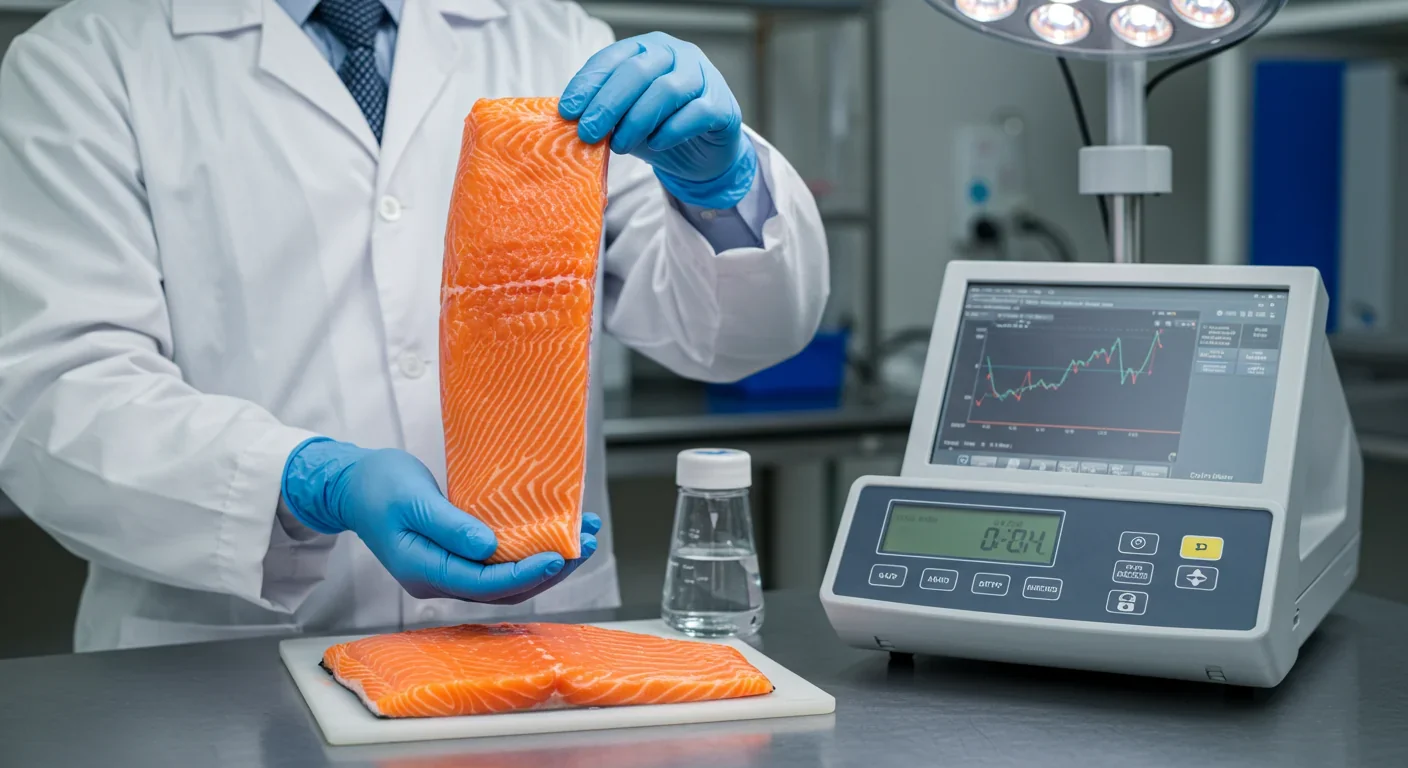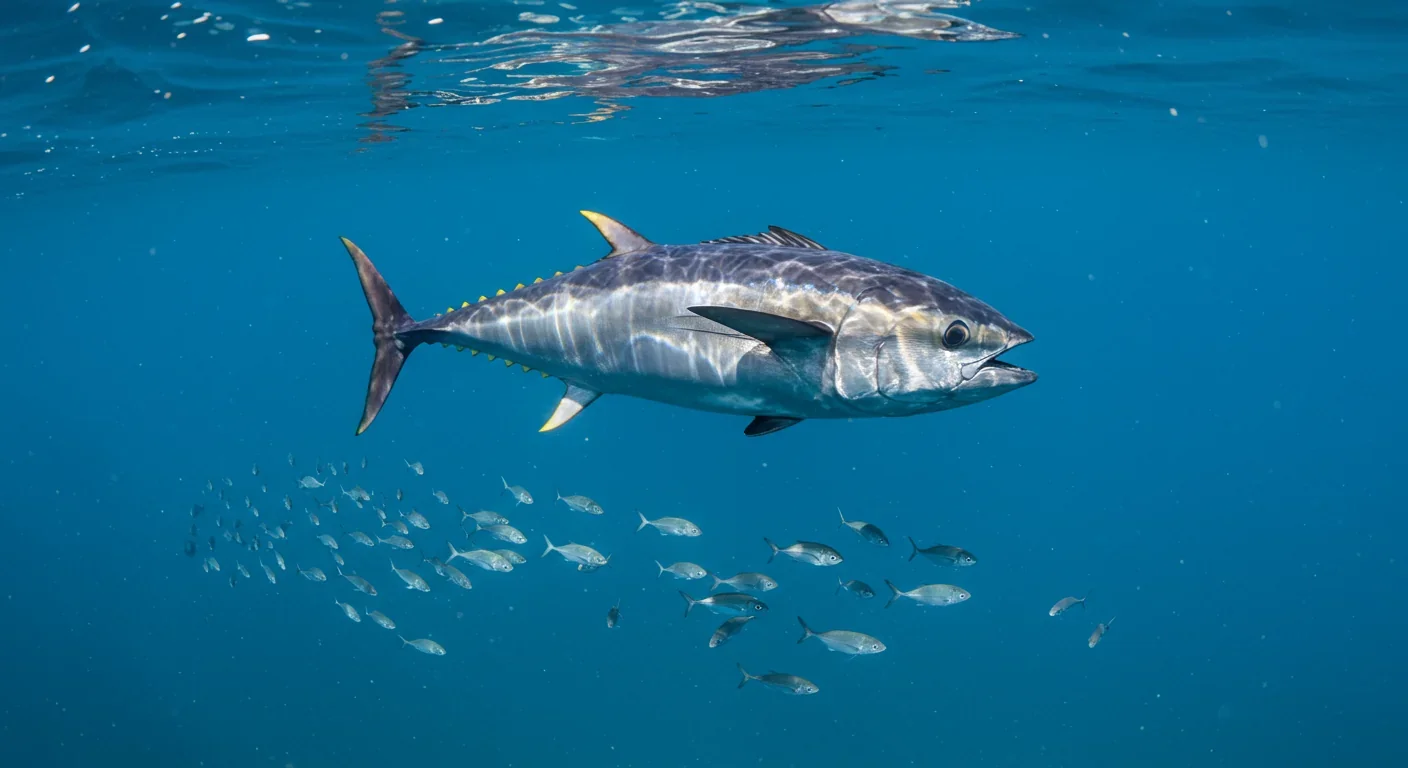Ultrafine Particles Breach Brain Barriers: Hidden Risk

TL;DR: Toxins like mercury and PCBs concentrate as they move up the food chain through biomagnification, turning trace contaminants into health risks. Understanding which fish to eat, how often, and supporting cleaner ecosystems helps protect your health.

Your dinner plate might hold a hidden danger that started its journey in microscopic algae weeks or even months ago. It's not about freshness or food poisoning in the traditional sense. It's about biomagnification, a process so insidious that by the time toxins reach your fork, they've become hundreds or even thousands of times more concentrated than when they first entered the food chain. That tuna steak or salmon fillet? It could contain mercury levels that would never exist in nature if not for this silent amplification mechanism that turns trace contaminants into genuine health threats.
Biomagnification works like a terrible savings account where only the bad stuff accumulates. When toxins like mercury, PCBs, or pesticides enter an ecosystem, they don't just wash away. Instead, they get absorbed by the smallest organisms—plankton, algae, tiny invertebrates—and stick around because these chemicals are fat-soluble. They dissolve into fatty tissues and stay there.
Here's where it gets concerning. A small fish eats hundreds of contaminated plankton. Each plankton carries a tiny amount of mercury, but together they add up. That small fish now has a higher concentration of mercury in its body than any single plankton did. Then a bigger fish eats dozens of those small fish, accumulating all their mercury. The process repeats, and by the time you reach apex predators like tuna, swordfish, or sharks, the concentration can be 10,000 times higher than in the water itself.
The key factor is that these toxins are persistent. Unlike nutrients that get metabolized or excreted, substances like methylmercury and PCBs (polychlorinated biphenyls) bind to proteins and fats in tissue. Fish efficiently absorb methyl mercury but excrete it very slowly, causing buildup over their lifetime. This biological retention means every meal adds to the burden, creating a toxic legacy that climbs the food web.
Tuna is perhaps the most widely recognized example of biomagnification affecting human diets. Not all tuna is created equal when it comes to mercury. The differences are stark and depend largely on the species and their position in the marine food web.
Light tuna typically contains about 0.126 parts per million (ppm) of mercury, while albacore reaches 0.350 ppm. Yellowfin sits at 0.354 ppm, and bigeye tuna tops the chart at 0.689 ppm. These numbers might seem small, but in context they're significant. The EPA recommends that people eating fish regularly should limit consumption to species with lower mercury levels.
Why the variation? Larger, longer-lived tuna species spend more time accumulating mercury from their prey. Bigeye tuna can live 15 years or more and feed on smaller fish that have already concentrated mercury in their flesh. Each meal adds to the total burden, and because tuna are highly active predators with high metabolic rates, they consume massive quantities of prey. A single bigeye tuna can contain mercury levels that represent the accumulated toxin load of thousands of smaller fish.
The health implications are real. High mercury exposure can lead to brain cell death and impair fine motor skills, memory, and focus. Pregnant women and young children face the greatest risks because mercury crosses the placental barrier and disrupts neural development. That's why health authorities recommend limiting albacore and yellowfin consumption to once per week and avoiding bigeye tuna altogether during pregnancy.
While mercury dominates headlines, PCBs present an equally concerning contamination story, especially in farmed salmon. These industrial chemicals were banned decades ago, but they persist in sediments and continue cycling through aquatic food webs.
Research has consistently shown that farmed salmon contains higher levels of PCBs than wild salmon. One landmark study analyzing over 700 salmon samples found that farm-raised Atlantic salmon had significantly elevated levels of 13 out of 14 organochlorine toxins compared to wild Pacific salmon. The concentrations were highest in European and North American farms.
Why do farmed fish accumulate more toxins? The answer lies in their feed and fat content. Farmed salmon are fed processed pellets often containing fishmeal made from smaller fish like anchovies and sardines. These feed fish have already accumulated PCBs and other persistent organic pollutants. Since PCBs are stored in fat, and farmed salmon are fattier than their wild counterparts (about 10.5 grams of fat per 3-ounce serving versus 7 grams in wild salmon), they have more capacity to store these contaminants.
The concentration effect is biomagnification in action. Small fish accumulate PCBs from plankton and invertebrates. These small fish are processed into feed. Farmed salmon eat concentrated amounts of this feed daily for years, and the PCBs accumulate in their fatty tissue. When you eat that salmon, you're consuming the bioaccumulated burden of potentially thousands of smaller organisms.

Biomagnification isn't limited to aquatic systems. Pesticides like DDT (now banned but still present in ecosystems) and modern alternatives follow similar patterns in terrestrial food webs. Birds of prey like eagles and hawks have historically suffered from pesticide accumulation, famously leading to eggshell thinning and population crashes in the mid-20th century.
Even today, agricultural runoff carries pesticide residues into waterways, where they enter aquatic food chains. From there, they can move into terrestrial predators like otters, bears, and raptors that feed on fish. Produce can also carry pesticide residues, though biomagnification is less pronounced in plant-based foods since plants occupy the base of food chains rather than higher trophic levels.
The concern shifts when you consider animals that eat contaminated plants. Herbivorous fish consuming algae with trace pesticides, or insects feeding on treated crops, start the concentration process. Predators feeding on these organisms—whether bass eating insects, or birds eating small fish—continue the amplification. The pattern repeats: each trophic level increases the concentration.
The human health effects of chronic low-level toxin exposure are complex and often subtle. Unlike acute poisoning, biomagnification-related health issues develop over years or decades of consumption. The impacts vary based on the specific toxin, exposure level, and individual vulnerability.
Mercury's neurotoxic effects are well-documented. The EPA estimates that 8% of women of childbearing age have mercury levels in their blood that could pose risks to a developing fetus. Symptoms in adults include tremors, insomnia, memory loss, and neuromuscular changes. In children exposed in utero, the effects can include cognitive deficits, attention problems, and delayed development.
PCBs affect multiple body systems. They're classified as probable human carcinogens and have been linked to immune system suppression, reproductive disorders, and thyroid disruption. Because they persist for years in human tissue, effects can compound over time. One troubling aspect is that PCBs can transfer through breast milk, potentially exposing infants to accumulated maternal burdens.
Wildlife populations have served as early warnings for these dangers. The famous case of DDT causing eggshell thinning in bald eagles and peregrine falcons in the 1960s and 1970s demonstrated how apex predators suffer most from biomagnification. Orcas, sitting atop the marine food web, carry some of the highest PCB concentrations of any mammals on Earth. Some populations are considered among the most contaminated animals in the world.
Governments have responded to biomagnification risks with a patchwork of regulations, consumption advisories, and international agreements. The approaches vary by toxin and jurisdiction, but common themes include source reduction, monitoring, and public education.
The EPA maintains extensive fish consumption advisories that specify safe serving sizes based on mercury levels. These recommendations are particularly strict for vulnerable populations like pregnant women and young children. For example, the guidance suggests that women of childbearing age limit albacore tuna to 6 ounces per week.
The 2012 Mercury and Air Toxics Standards (MATS) regulation targeted the primary source of mercury pollution: coal-fired power plants. This regulation aims to reduce about 90% of power plant mercury emissions, with estimated health benefits ranging from $37 billion to $90 billion by 2016. Yet despite these controls, legacy contamination persists.
Internationally, the World Health Organization provides guidance on mercury exposure limits. The Minamata Convention on Mercury, adopted in 2013, represents a global treaty to reduce mercury emissions and phase out mercury-containing products. The Stockholm Convention on Persistent Organic Pollutants addresses PCBs, DDT, and other biomagnifying chemicals, requiring countries to eliminate or restrict their production and use.
Still, enforcement varies widely. Some fish tested in U.S. streams exceed EPA safety levels, with 25% of samples from 291 streams showing mercury above recommended thresholds. Even in remote waterways far from industrial activity, atmospheric deposition of mercury from distant coal plants creates contamination.
One underappreciated aspect of biomagnification is that reducing emissions doesn't immediately solve the problem. Mercury and PCBs already deposited in sediments can remain active for decades. Bacteria convert elemental mercury in sediments into methylmercury, the organic form that efficiently enters food webs.
This re-emission process means there's a substantial lag between emission controls and measurable improvements in fish contamination levels. Even as coal plants shut down and industrial PCB use becomes history, these toxins continue cycling through ecosystems. Sediment disturbance from storms, dredging, or other activities can release sequestered contaminants back into the water column.
The persistence of these chemicals is extraordinary. PCBs have half-lives measured in years to decades in the environment. In human tissue, some PCB congeners can persist for 10 years or more. This longevity means that decisions made generations ago continue affecting our food supply today.

Given the pervasiveness of these toxins, what can consumers do to protect themselves and their families? The answer involves informed choices rather than food avoidance.
Diversify fish consumption. Don't eat the same species repeatedly. Variety dilutes risk because different species accumulate different contaminant profiles. Smaller, shorter-lived fish like sardines, anchovies, and herring generally contain lower mercury levels. These species occupy lower trophic positions and have less time to accumulate toxins.
Choose wild salmon when possible. While farmed salmon offers nutritional benefits, wild-caught salmon typically contains fewer PCBs. If choosing farmed salmon, look for products from regions with stricter environmental standards.
Follow consumption advisories. The EPA and state health departments publish fish consumption guidelines based on local contamination data. These advisories provide species-specific recommendations for meal frequency. Pregnant women should be especially vigilant, potentially avoiding high-mercury species entirely.
Consider the source. Fish from contaminated waterways carry higher burdens. Local fishing advisories often identify specific water bodies with elevated contamination. Ocean-caught fish from clean waters generally pose lower risks than fish from polluted rivers or coastal areas.
Trim fat from fish before cooking. Since many persistent organic pollutants concentrate in fatty tissue, removing skin and visible fat reduces exposure to PCBs and similar compounds. This is less relevant for mercury, which binds to muscle proteins.
Balance benefits and risks. Fish provides high-quality protein, omega-3 fatty acids, and numerous vitamins and minerals. The health benefits of moderate fish consumption typically outweigh the risks for most adults. The key is informed moderation.
Individual dietary choices matter, but systemic change requires broader environmental action. Consumers can support policies and practices that reduce toxin inputs at the source.
Advocate for clean energy. Coal combustion remains the largest source of atmospheric mercury deposition. Supporting renewable energy transitions and stronger emission controls reduces future contamination. This is a long-term investment in food safety.
Support sustainable aquaculture. Not all fish farming is created equal. Operations that use low-contaminant feed ingredients, implement waste treatment, and avoid polluted waters produce cleaner products. Consumer demand for responsibly farmed fish incentivizes these practices.
Reduce pesticide use. On a personal level, this means choosing organic produce when feasible and avoiding pesticides in home gardens and landscaping. On a policy level, it means supporting regulations that restrict the most persistent and bioaccumulative pesticides.
Participate in cleanup efforts. Removing legacy contamination from sediments is expensive and technically challenging, but targeted remediation of hotspots can reduce ongoing exposure. Supporting environmental restoration projects—through volunteering, donations, or political advocacy—contributes to long-term solutions.
Stay informed. Science continues revealing new information about contaminant pathways, health effects, and remediation strategies. Following credible sources like the EPA, WHO, and peer-reviewed research helps consumers make evidence-based decisions.
Biomagnification reminds us that environmental health and human health are inseparable. The toxins we release into ecosystems don't disappear—they transform, concentrate, and eventually return to us through our food. Understanding this process empowers better choices and smarter policies.
Progress has been made. DDT use dropped dramatically after its ban, and eagle populations have recovered. Mercury emissions from power plants have declined thanks to regulations. PCB production ended decades ago in most countries. Yet these victories are incomplete. Legacy contamination persists, and new chemicals with unknown biomagnification potential enter commerce regularly.
The science of biomagnification offers a lens for evaluating chemical risk before problems escalate. Does a substance accumulate in organisms? Is it persistent in the environment? Does it concentrate as it moves up food chains? Answering these questions early could prevent the next mercury or PCB crisis.
For now, consumers navigate a complex landscape where nearly every fish carries some contaminant burden, yet fish remains one of the healthiest foods available. The solution isn't to abandon seafood but to choose wisely, eat diversely, follow expert guidance, and push for systemic environmental improvements. Your plate reflects the health of the planet's waters. Making that reflection clearer requires effort at every level, from individual dinner decisions to international environmental treaties.
The toxins that started in algae can indeed trigger alarms in your kitchen, but knowledge transforms that alarm into informed action. Understanding biomagnification isn't about fear—it's about recognizing the connections between industrial emissions, ecosystem health, and personal wellness. Those connections, once seen, become impossible to ignore.

MOND proposes gravity changes at low accelerations, explaining galaxy rotation without dark matter. While it predicts thousands of galaxies correctly, it struggles with clusters and cosmology, keeping the dark matter debate alive.

Ultrafine pollution particles smaller than 100 nanometers can bypass the blood-brain barrier through the olfactory nerve and bloodstream, depositing in brain tissue where they trigger neuroinflammation linked to dementia and neurological disorders, yet remain completely unregulated by current air quality standards.

CAES stores excess renewable energy by compressing air in underground caverns, then releases it through turbines during peak demand. New advanced adiabatic systems achieve 70%+ efficiency, making this decades-old technology suddenly competitive for long-duration grid storage.

Our brains are hardwired to see patterns in randomness, causing the gambler's fallacy—the mistaken belief that past random events influence future probabilities. This cognitive bias costs people millions in casinos, investments, and daily decisions.

Forests operate as synchronized living systems with molecular clocks that coordinate metabolism from individual cells to entire ecosystems, creating rhythmic patterns that affect global carbon cycles and climate feedback loops.

Generation Z is the first cohort to come of age amid a polycrisis - interconnected global failures spanning climate, economy, democracy, and health. This cascading reality is fundamentally reshaping how young people think, plan their lives, and organize for change.

Zero-trust security eliminates implicit network trust by requiring continuous verification of every access request. Organizations are rapidly adopting this architecture to address cloud computing, remote work, and sophisticated threats that rendered perimeter defenses obsolete.